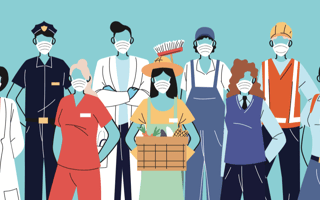Essential workers have gotten a lot of applause over the course of the COVID-19 pandemic. Unable to work from home, delivery drivers, hospital staff, electricians and more have braved the unknown in order to do something familiar — their work, which has kept the rest of the world afloat.
Applause is nice, but Zello wants to do these workers one better. The team is on a mission to build great tech that they actually want to use.
“Frontline workers have been ignored by technology companies,” Bill Moore, CEO of Zello, said. “They’re using pen and paper and 100-year-old radio technology. You won’t believe the number of delivery drivers who drop off your package, then head back to their vehicles to fill out paperwork.”
In a culture that runs on efficiency, a huge segment of the population has been left behind. But, according to Moore, the fast-growing company is here to bring these workers the best technology.
The company’s push-to-talk app was built to replace the outdated walkie-talkie systems that workers like truck drivers, construction teams and first responders often rely on. Zello’s app is easy to use, doesn’t suffer from static interference, and can be used with hands-free technology — all vital elements for those in the field.
In fact, even when workers aren’t provided with Zello in their professional toolkit, many on the frontline opt to use the version designed for friends and family — “because that’s better than what their employers had given them,” Moore said.
To learn more about how Zello is supporting those on the frontlines, Built In Austin connected with Moore. He filled us in on how the team designs tech with essential workers in mind, the free initiatives the company stands behind and the impact this work has on the Zello team.

What’s Zello building?
Tell us a bit about the tech Zello is building. How is it helpful for frontline workers?
CEO Bill Moore: Humans are social animals. Most of us prefer to interact with others during the day, but many frontline workers are isolated in a truck or on a forklift in a loud environment. That isolation isn’t good for the soul, and it’s not good for employers because when isolated individuals don’t have roots, there’s nothing to keep them there. Connecting with live voice helps workers be a tribe, which plays a role in worker retention.
Live voice is also essential during times of crisis or safety incidents. Our voices communicate emotion and meaning that a text message just can’t. A few seconds of someone’s voice instantly communicates what’s going on. We’ve replaced the emergency alert buttons on radios with smarter mobile technology that, when triggered, opens up the microphone on your smartphone, shuts down other communication and flags the attention of people who listen for emergency communications so that they can respond and take action.
Our voices communicate emotion and meaning that a text message just can’t.”
How are Zello’s solutions different from what frontline workers usually work with?
Frontline workers traditionally talk through radios, but radios don’t sound great. They are bulky, their signals don’t reach very far and they often don't work with the many accessories that frontline workers toggle between. Not to mention, everybody has to listen to chatter on open channels.
Employees often wind up just bringing in their own phones and using them to text and call. That’s a safety risk, and their personal apps aren’t optimized for the job. It’s also not ideal for employers because this can create liability issues.
Mobile push-to-talk technology is fundamentally better than radio. Push-to-talk on a smartphone is as easy as it is on a radio — it’s just a single push. But unlike radio, mobile technology sounds great and works across long distances. This can even allow employees, such as dispatchers, to work from home, which we saw a lot of during COVID-19.
At the same time, Zello is safer than standard smartphone features because it’s designed to minimize distraction, allowing users to keep their eyes on the road and their hands on their tools.
Former frontline workers welcome
What unique needs do frontline workers have — and how does the company work to support these needs?
Frontline workers often operate in rugged environments such as construction sites, in truck cabs or in hospital settings. They need hearty devices with range. First responders and rescuers, for instance, will often find themselves losing radio signal when they go into or between tall buildings, or are in a rural setting away from radio towers.
Our technology leverages modern communication technologies in a radio-like experience with all the connectivity of a smartphone. Zello works on rugged phones and with a wide range of accessories that further increase safety, such as Bluetooth headsets and speaker mics, which keep everything single-touch.
Our technology leverages modern communication technologies in a radio-like experience with all the connectivity of a smartphone.”
First responder teams that prefer their own radio systems but want to expand their range can use radio gateways, which connect Zello to their systems and bridge their networks. These teams also use our channels feature to set up command centers quickly for coordinating emergency responses across departments that have responded from across a region during a natural disaster.
Additionally, because our solution is digital, we can offer analytics and metrics to managers and organizations looking to evaluate their operations.
Tell us a bit about the Zello for First Responders program. What was the motivation behind rolling this out?
The Zello for First Responders program makes our premium product available to organizations for free. Fire, police and rescue organizations are just a few that participate. The growing program already supports 1,200 organizations with 140,000 users.
The idea came about from a conference I was speaking at for first responders about legacy-style radios. I asked, “How many of you have heard of Zello?” Many hands went up. Then I asked, “How many of you use it at work?” Most of the hands stayed up. Because we had not sold much to first responders, those people were probably using the version designed for friends and family — because that’s better than what their employers had given them. Police officers and ambulance drivers use the company-supplied radios plus Zello on their personal phones.
Our idea was to give away the technology to these important members of our society who were already using it organically. It’s a light load to give away a great communication solution to first responders who are doing such an incredible amount of good in the world.
One of the organizations we work with, Crowdsource Rescue, actually started using Zello during Hurricane Harvey by matching neighbors that needed rescuing from flooded homes with neighbors that had boats. They communicated over Zello the whole time. When we saw that, we got them enrolled in our first responder program. It seems like every time there’s crisis anywhere in the world, I get personal emails from those running rescue organizations thanking us for providing our work solution to them for free.
Why are Zello products rewarding for technologists to build?
Zello is a product-lead company with a product founder, so it’s a wonderful environment for technologists. When I asked this question to our technical teams, I kept hearing the same answer: At Zello, you get to solve interesting problems. And unlike larger organizations, here you get immediate, real-time feedback about what works. You rapidly get to see your work in the field.
I think the overlap of scalability, security, administration and end-user ease-of-use creates interesting problems to solve. How do we ensure all of these essentials are here, while also making the app so simple that frontline users don’t need training, an email address or a phone number to join? Our team is still relatively small, and yet when you work with us, you’re working personally to scale to hundreds of millions of users. That’s a pretty special environment.
At Zello, you get to solve interesting problems. And unlike larger organizations, here you get immediate, real-time feedback about what works.”
How does Zello’s people-first, feedback-driven mindset apply to the company culture?
From frontline workers to employees, we’re a people-centric organization. We prioritize individuals and their lives. As a company, that means we give people the compensation, the benefits and the tools they need to thrive. We also focus hard to preserve autonomy. People are encouraged to try, which means they’re also encouraged to make mistakes, learn from them and improve. We offer recognition, rewards, coaching and mentoring for every person who works here. When we’ve asked employees why they like working here, the number one reason they say is the people they get to work with.
Zello is still in the early stages of our business with an amazing future ahead, but we didn’t start four months ago. We’re a company with millions of users and real responsibilities, so there’s a sense of something solid beneath our feet. We attract people who feel that purpose and impact are important. They’re attracted to our authenticity. With that authenticity comes a sense of humility and empathy, which creates an environment of trust that attracts and retains like-minded people. As a result, employee churn is low and employee satisfaction is high.
What does the future of Zello look like? What are you most excited about?
Zello is already used as a verb in certain segments of the workforce. We love hearing customers say ‘I'll Zello you’ and we expect this to spread even further. We will more than double the number of employees we have by next year.
The market and the opportunity for us is unbelievably large. Eighty percent of workers all around the globe are frontline workers — that translates to billions of people. There are very few markets that have that kind of scale. We’ve seen other big companies try to get into what we do before, which is exciting validation, but they’ve stumbled over the technology required to deliver an instant, radio-like experience at scale. We’re already in the space, doing it better than anyone else.








